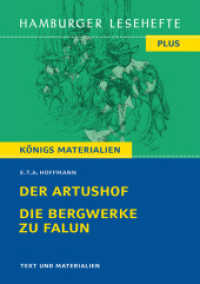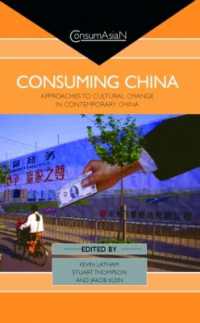- ホーム
- > 洋書
- > 英文書
- > Business / Economics
Full Description
This volume mainly focuses on the relevance and application of Heckscher-Ohlin Model and Specific Factors Model of trade, while also addressing other latest global issues which are connected with two most celebrated structures of trade models developed by the legendary trade theorist Prof. Ronald Winthrop Jones. The two models were published as 'The Structure of Simple General Equilibrium Models' (1965) and 'A Three Factor Model in Theory, Trade and History' (1971). Both the structures are used extensively by trade economists and development economists to decipher a bunch of interesting and intertwined ideas. The models being easy to follow, are capable of explaining some contemporary global concerns if modified judiciously. This includes both theory and policy in both competitive and imperfectly competitive markets. It also has some empirical dimensions.
This book is a must read for those who want to keep abreast of latest frontiers in the domain of research on internationaltrade theory and policy, especially advanced graduate students, researchers, and policy makers in general. It exposes its readers to methodological techniques and contemporary research issues so that one can easily draw clues, in terms of both relevant techniques and future research directions, to carry on their own research; policy makers can understand the channels of possible welfare improvement owing to new policy changes.
Contents
Chapter 1: Tariff-Rebate on Intermediate Inputs for Exportables in a Two-period Model with Learning-from-Exporting.- Chapter 2: Trade Policy during COVID.- Chapter 3: Ronald W. Jones as a General Equilibrium Theorist in a Classical Mold: International Trade through the Ricardo-Viner-Jones Model.- Chapter 4: A Simple Dynamic Specific-Factor Model with Sector-Specific Investments as Joint Production Activities.- Chapter 5: The Specific Factors Model: A User-Friendly Approach to Interests and Policy.- Chapter 6: Ricardian Comparative Advantage in the Heckscher-Ohlin Economy with Public Infrastructures.- hapter 7: Agritourism, the Inflow of Foreign Workers and Economic Welfare in a Developed Country.- Chapter 8: Emissions Trading and International Trade.- Chapter 9: Trade, Union and Welfare in Generalized Oligopoly Equilibrium.- Chapter 10: Rural Employment Guarantee and Rural Minimum Wage: A General Equilibrium Analysis.- Chapter 11: Strategic trade policy in a vertical structure withcross ownership.- Chapter 12: Harmonization of Intellectual Property Rights: Impact on India's Pharmaceutical Exports.- Chapter 13: Value Chain in Discrete Stages, Input Trade, and Distribution of Incomes.- Chapter 14: Effect of Unskilled Labour Migration on a Small Open Developed Economy.- Chapter 15: Crime, Efficiency of Labour and Trade: A Theoretical Analysis.- Chapter 16: Trade in Intermediates, Industrial Threshold and Sustainable Emission in South Asia.- Chapter 17: Foreign Direct Investment, Technology Transfer and Pollution Abatement in a Small Open Economy.- Chapter 18: Industrial Location: Geography and Fiscal Competition.- Chapter 19: Tariff that Exports Unemployment: Home Market Effect Meets Shapiro and Stiglitz.- Chapter 20: Role of Foreign Direct Investment in Explaining the Wage Premium: Theoretical and Empirical Analyses for an Emerging Market Economy.- Chapter 21: Labour, Trade, and Wage Inequality: Some New Results.- Chapter 22: Trade and Investment Liberalisation,Human Capital Formation and Child Labour: A Theoretical Perspective.- Chapter 23: Impact of Social Liberalization on Gender based Wage Inequality and Unemployment: A Theoretical Analysis.- Chapter 24: Productivity Shocks and Wage Dispersion.- Chapter 25: External shocks in the presence of informal wage employment and self-employment: How is gender wage inequality affected?.- Chapter 26: Controlling Environmental Pollution, Sectoral Composition and Factor Prices: A H-O and SFM Hybrid Approach.- Chapter 27: Multi-National Corporations and Financial Fueling of Terrorism in the Shadow of Globalization: Transfer Pricing, Illegal Trading and Enforcement Strategies.- Chapter 28: Sectoral Wage Gap Due to FDI Inflow in the Artificial Intelligence Induced Non-Traded Sector of an Open Economy.- Chapter 29: Licensing in Cournot Duopoly in presence of Mixed Technology.








